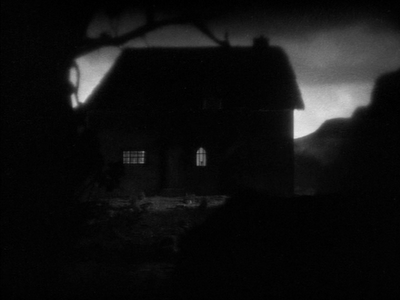“In a small-town hairdressing salon, a young barber, Joe (Uno Henning) is trying to court Sally, the beautiful manicurist (Nora Baring) and asks her out. She rejects him in favour of the security offered by an older, wealthier farmer. In a jealous rage Joe slashes the farmer with a razor and is sent to Dartmoor prison for attempted murder. He escapes over the moors to find Sally, who does not know if he has come to kill her or ask her forgiveness, and it's at this point that the film begins. The rest of the story is told in flashback.” (BFI Filmstore 2008)
Anthony Asquith’s obscure, blackly comic A Cottage on Dartmoor is a triumphant last-hurrah of silent British cinema. A deceptively simple tale of sexual jealousy which takes inspiration, style and techniques from a number of international sources. Released in 1929, the film sits on the transitional cusp between silent and talkie in British Cinema. As a young Alfred Hitchcock earned critical and financial success with his sound thriller, Blackmail, A Cottage on Dartmoor announced it’s artistic and cinematic intention against the unreceding tide of new technology. It is a love letter to the medium of silent film which achieves its narrative ambitions through the use of moody cinematography, theatrical acting and stylistic editing.
The film’s most effective scene brings all this outside influence into a fantastic cinematic sequence. The scene, set in a cinema during the showing of a ‘Talkie’ film, makes a clever reference to the mediums own fragility but also presents a showcase of its unique qualities as an aesthetic We never the see the film on show, instead the action is concentrated entirely on the faces of the audience as a bombastic musical sequence delivers incredible suspension as Joe sits in the shadows, stalking the dating couple. His jealousy becomes more deep-seated after each passing second, each single cut of an Eisenstein inspired montage sequence. Murder is preceded by the quaintness of cricket and lawn tennis, who would've thought such a thing possible. Delivered without a moment of dialogue it's proof cinema is allowed to flourish, pure image becomes transcendent of the medium.
The film is often favourably compared to the early works of Hitchcock and demonstrated the potential of Asquith to be one of the more visually inventive British filmmakers of his time. Sadly, his career became decidedly mundane as it developed but there’s no doubt A Cottage on Dartmoor remains a virtuoso piece of directorial panache. Just look at these sumptuous shots!
A Cottage on Dartmoor, opening stills
Bibliography
BFI Filmstore (2008) A Cottage on Dartmoor At: http://filmstore.bfi.org.uk/acatalog/info_8666.html (Accessed 09/10/2012)
Kehr, D (2007) New DVDs: A Cottage on Dartmoor At: http://www.nytimes.com/2007/11/27/movies/homevideo/27dvds.html?ref=movies&pagewanted=print (Accessed 09/10/2012)
Ryall, T (2005) Anthony Asquith Great Britain: Manchester University Press


















0 comments:
Post a Comment